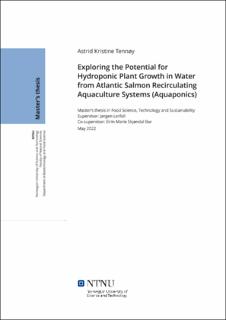| dc.contributor.advisor | Lerfall, Jørgen | |
| dc.contributor.advisor | Bar, Eirin Marie Skjøndal | |
| dc.contributor.author | Tennøy, Astrid Kristine | |
| dc.date.accessioned | 2022-07-06T17:20:57Z | |
| dc.date.available | 2022-07-06T17:20:57Z | |
| dc.date.issued | 2022 | |
| dc.identifier | no.ntnu:inspera:110155679:36276738 | |
| dc.identifier.uri | https://hdl.handle.net/11250/3003277 | |
| dc.description.abstract | Den globale befolkningen vokser stadig, og FN spår at den vil nå 9,8 milliarder i 2050. For å sikre denne veksten, må en betydelig økning i matproduksjonen til. Dette er problematisk på grunn av utfordringer knyttet til knappe ferskvannsressurser, mangel på egnet jordbruksareal, og forurensning av miljøet. Nye metoder for bærekraftig matproduksjon må utforskes for å sikre sunn og trygg mat for mennesker og miljø. Norge har en stor havbruksnæring, som anses viktig i produksjon av bærekraftig animalsk protein. Resirkulerende akvakultursystemer (RAS) gir full kontroll over alle parameter inn og ut av systemene, noe som gir mulighet for økt produksjon og oppsamling av avfallsprodukter. Avfallsproduktene består av verdifulle næringsstoffer som nitrogen og fosfor, som kan utnyttes videre. Gjennom å kombinere RAS og hydroponisk vekst av grønnsaker kan man skape et mer bærekraftig matsystem gjennom akvaponi, hvor avfallsprodukter fra fisk brukes som næringsstoffer for planter.
For å utforske potensialet for plantevekst i RAS-vann fra produksjon av atlantisk laks, ble det utført en litteraturstudie, samt et planteeksperiment. Hovedmålet var å se om salatproduksjon (Lactuca sativa) kunne brukes som filtreringsmetode for å fjerne nitrogen- og fosforforbindelser fra produksjonsvann i RAS med laksesmolt, for å erstatte denitrifikasjons- og de-fosforprosesser. Det ble hentet vann fra to steder i RAS; etter biofilteret og fra plateseparatoren. Resultatene indikerer at salatproduksjon kan brukes som en del av filtreringsprosessen for å fjerne nitrogen- og fosforforbindelser fra vannet, men filtreringen var for lav til å erstatte denitrifikasjons- og de-fosforprosesser. Plantene vokste likevel gjennom hele forsøket, på lik linje med jordplanter, og et potensiale for plantevekst ble observert. Det ble ikke observert signifikante forskjeller for planter i de to ulike vanntypene. Ved bruk av de-koblede systemer, kan man tilsette næringsstoffer og forbedre næringsløsningen i vannet fra RAS. Dette kan forbedre planteveksten og bidra til en sirkulær økonomi av vann og næringsstoffer tilgjengelig i RAS.
Denne forskningen bidrar til å fylle et behov for informasjon om akvaponi i kombinasjon med produksjon av atlantisk laks i RAS. Næringen forsker nå på hvordan man kan innlemme planteseksjoner i RAS og skape en mer bærekraftig matproduksjon. Mye av litteraturen på akvaponi er relatert til varmtvannsarter, og det er få vitenskapelige publikasjoner om kaldtvannsarter som atlantisk laks. | |
| dc.description.abstract | The global population is constantly growing, and the UN predicts the population to reach 9,8 billion in 2050. A significant increase in food production to secure this growth is problematic due to challenges with scarce freshwater resources, lack of agricultural land, pollution, and eutrophication. New methods for sustainable food production must be explored to secure healthy and safe food for both people and the environment. Norway has a large aquaculture industry, which is considered important in the production of sustainable animal protein. Recirculating aquaculture systems (RAS) provide full control of all inputs and outputs of the aquaculture system, allowing for an increased production and collection of waste products. The waste products consist of valuable nutrients such as nitrogen and phosphorus, which can be further utilized. Combining RAS and hydroponic growth of vegetables can create a more sustainable food system through aquaponics, where the waste products from fish are used as nutrients for plants.
To explore the potential of plant growth in RAS water from Atlantic salmon production, a literature review was performed, accompanied by a plant experiment. The main objective was to see whether lettuce (Lactuca sativa) production could be used as a filtering method to remove nitrogen and phosphorus compounds from water in RAS production of salmon smolt, to replace denitrification and de-phosphorus processes. Water was extracted from two locations in RAS; after the biofilter and from the plate separator. The results indicate that lettuce production can be used as part of the filtering process to remove nitrogen and phosphorus compounds from the water, but removal rates were too low to replace denitrification and de-phosphorus processes. Yet, plants grew throughout the experiment, similarly to soil plants, and there is a potential for plant growth. No significant differences were seen for plants in the two different water types. Adding nutrients to complement the RAS system, through decoupled systems can improve plant growth and contribute to a circular economy of water and nutrients available in RAS.
This research contributes to fill an information gap regarding aquaponics in combination with Atlantic salmon production in RAS. The industry is now researching how to integrate plant sections in RAS and create more sustainable food productions. Most data found on aquaponics is related to warm-water species and there are few scientific publications on cold-water species such as Atlantic salmon. | |
| dc.language | eng | |
| dc.publisher | NTNU | |
| dc.title | Exploring the Potential for Hydroponic Plant Growth in Water from Atlantic Salmon Recirculating Aquaculture Systems (Aquaponics) | |
| dc.type | Master thesis | |
